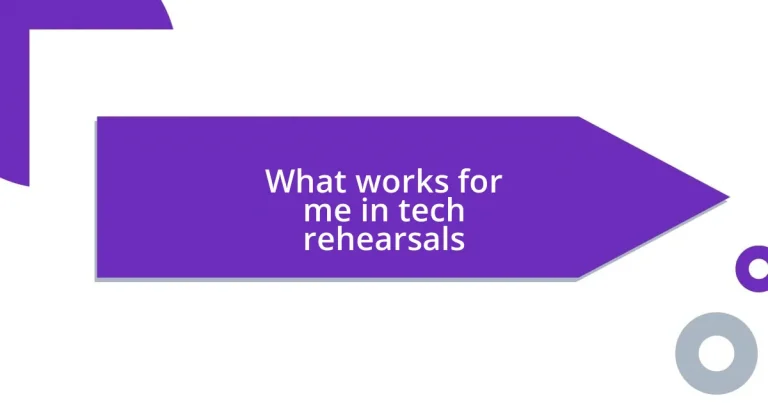Key takeaways:
- Tech rehearsals are crucial for synchronizing technical elements and enhancing overall performance quality.
- Effective preparation and communication among the team foster confidence, collaboration, and artistic integrity.
- Setting clear technical goals and managing time efficiently can improve focus and problem-solving during rehearsals.
- Adapting to changes with flexibility encourages innovation and can lead to unexpected, positive outcomes in the rehearsal process.
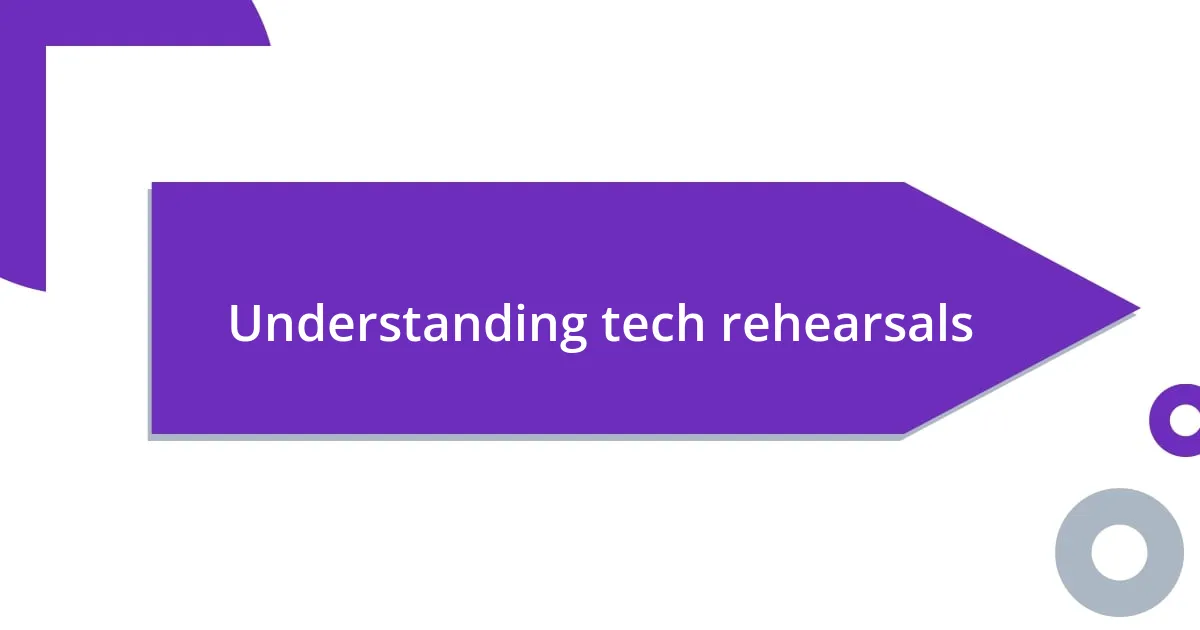
Understanding tech rehearsals
Tech rehearsals are essential for ensuring that all elements of a production come together seamlessly. I remember my first tech rehearsal—it was a whirlwind of emotion, with lighting cues and sound effects being tested while I tried to remember my lines. The energy was palpable; can you imagine the excitement mixed with anxiety? Understanding how these elements interplay can change how you perceive the entire performance.
During these rehearsals, the focus is not just on the actors but on every technical aspect, from cues to timing. I often find myself wondering, “What if the sound doesn’t sync?” or “Will the lights hit at just the right moment?” It’s those moments of uncertainty that really stress the importance of preparation. Missing a cue can throw everything off; it’s like a domino effect that can ripple throughout the show.
As I’ve navigated through various tech rehearsals, I’ve discovered that clear communication is vital. When stage managers and technicians come together with performers, that collaboration becomes the backbone of a successful production. Have you experienced the magic of a perfectly synchronized tech run? It can be a truly exhilarating moment!
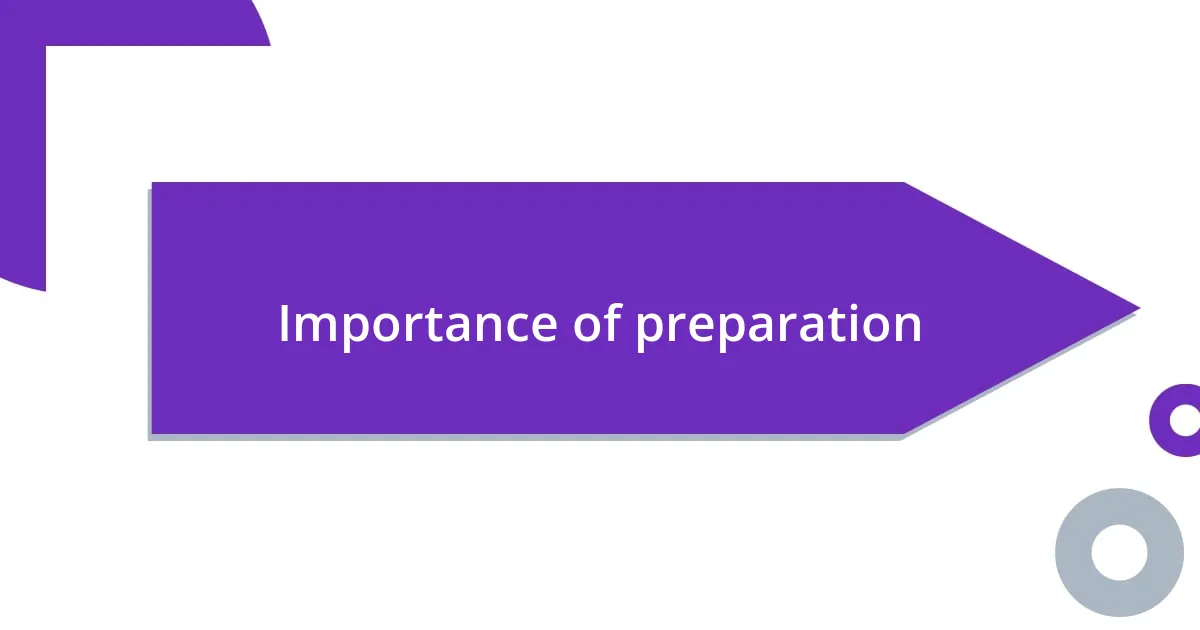
Importance of preparation
Preparation is the bedrock of any successful tech rehearsal. I’ve often felt that overwhelming moment just before a rehearsal starts, when all the intricate details—set designs, sound levels, and lighting cues—lie dormant, waiting for us to breathe life into them. I vividly recall an instance where we hadn’t fully tested a sound cue, and when it finally played during the run, it was a total disaster. The moment spiraled into chaos, reminding me how each element hinges on meticulous pre-show preparation.
To truly grasp the importance of preparation, consider the following points:
- Anticipating Challenges: Knowing potential pitfalls helps in devising solutions ahead of time.
- Confidence Building: Familiarity with the tech aspects boosts performers’ confidence.
- Streamlined Workflow: A well-prepared rehearsal reduces time wasted on troubleshooting during the actual performance.
- Team Cohesion: Effective preparation fosters stronger relationships among cast and crew, enhancing collaboration.
- Artistic Integrity: Ensuring every cue is precise preserves the vision of the production, making the performance feel authentic and polished.
These moments of preparation can transform your entire experience on stage. I’ve learned that when you’re well-prepared, the stress dissipates, leaving room for creativity and spontaneity during shows.
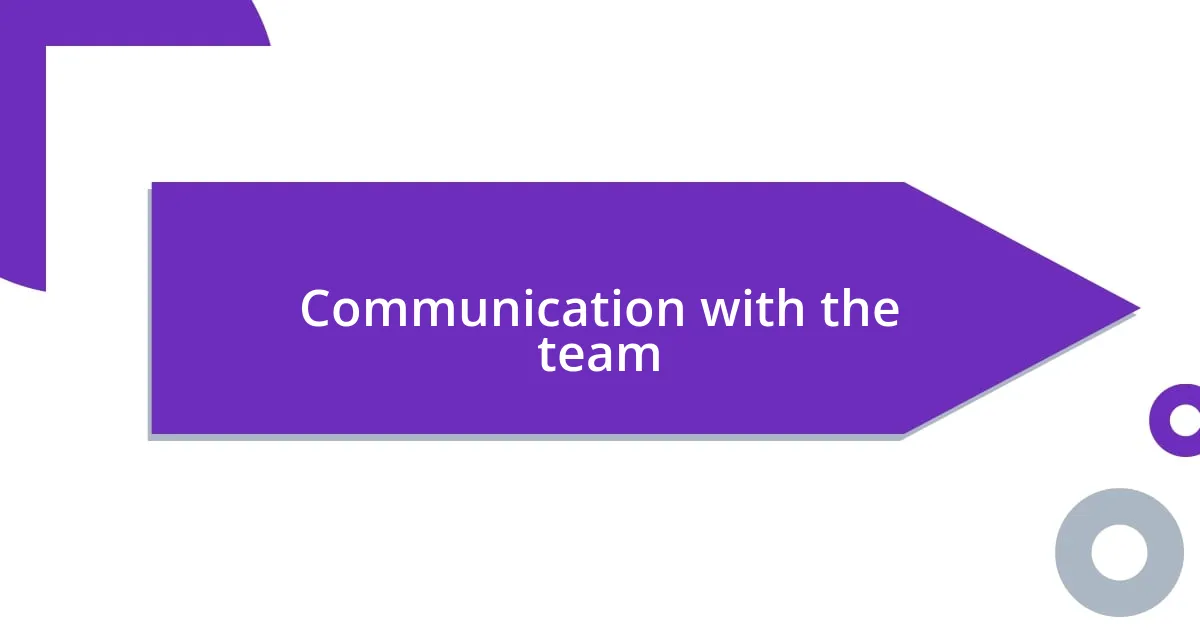
Communication with the team
When it comes to effective communication with the team, I can’t emphasize enough the importance of creating an open environment. I’ve found that when everyone feels comfortable expressing their thoughts, whether it’s about technical concerns or creative ideas, the entire production benefits. I remember a particularly challenging rehearsal where a last-minute change in lighting affected our timing. By encouraging team members to share their insights, we were able to address the issue swiftly and collaboratively, which made a world of difference.
Maintaining consistent communication throughout the process is key. I like to think of it as the glue that holds everything together. There was a time when our sound designer felt out of the loop regarding a scene change. Once we implemented daily briefings, the confusion melted away, and we transformed that initial misalignment into a seamless experience. A little dialogue can foster improved teamwork and ensure everyone is on the same page, ready to tackle the challenges that arise during tech rehearsals.
In my experience, utilizing different communication methods can enhance our efficiency and creativity. For instance, I often encourage using visual aids during our meetings, such as sketches of set designs or even short videos of lighting effects. I still recall a moment when a visual representation sparked an enlightening discussion among the crew, leading to adjustments that elevated our overall performance. Being proactive to communicate in varied ways makes the rehearsal process much more engaging and dynamic.
| Communication Method | Advantages |
|---|---|
| Open Dialogue | Encourages team input and problem-solving |
| Daily Briefings | Keeps everyone informed about changes |
| Visual Aids | Sparks creativity and aids understanding |
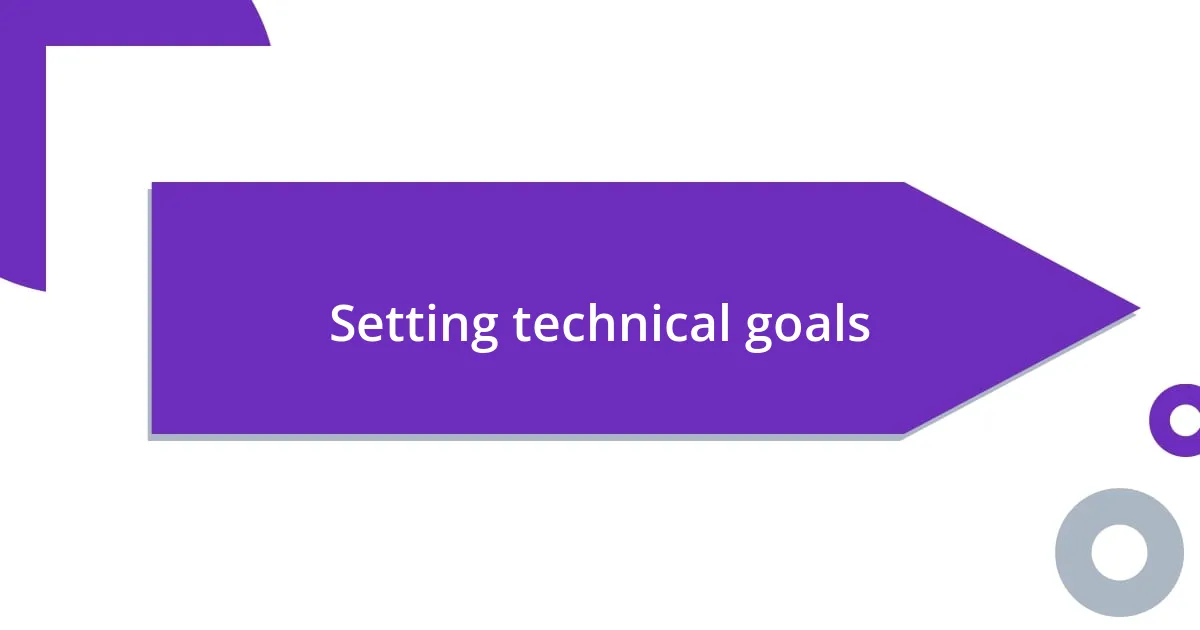
Setting technical goals
Setting technical goals is essential for a successful rehearsal. I always start by defining clear, measurable objectives that keep the team focused and motivated. For example, setting a goal to achieve perfect sound balance in the first half of rehearsal helps everyone understand what needs immediate attention, making it feel like we’re actively working toward something tangible.
From my own experience, it’s not just about technical specifications; it’s about fostering a collaborative spirit. I once set a target for all lighting changes to be executed flawlessly during our run-through. Rather than simply relying on individual expertise, I encouraged team members to brainstorm solutions to technical hurdles together. How often do we overlook the power of collective input? That collaboration not only improved our end result but also created a sense of shared ownership among the crew.
Moreover, I’ve learned that revisiting these goals regularly during rehearsals can keep the energy alive. I like to ask the team, “Are we on track? What adjustments can we make?” Reflecting on our progress reminds us all of the importance of flexibility in achieving our objectives. There was a memorable rehearsal where hitting our sound cue timing became a priority, and together, we managed to find solutions that felt rewarding. That collaborative effort didn’t just enhance our technical execution; it built a deeper connection within the team.
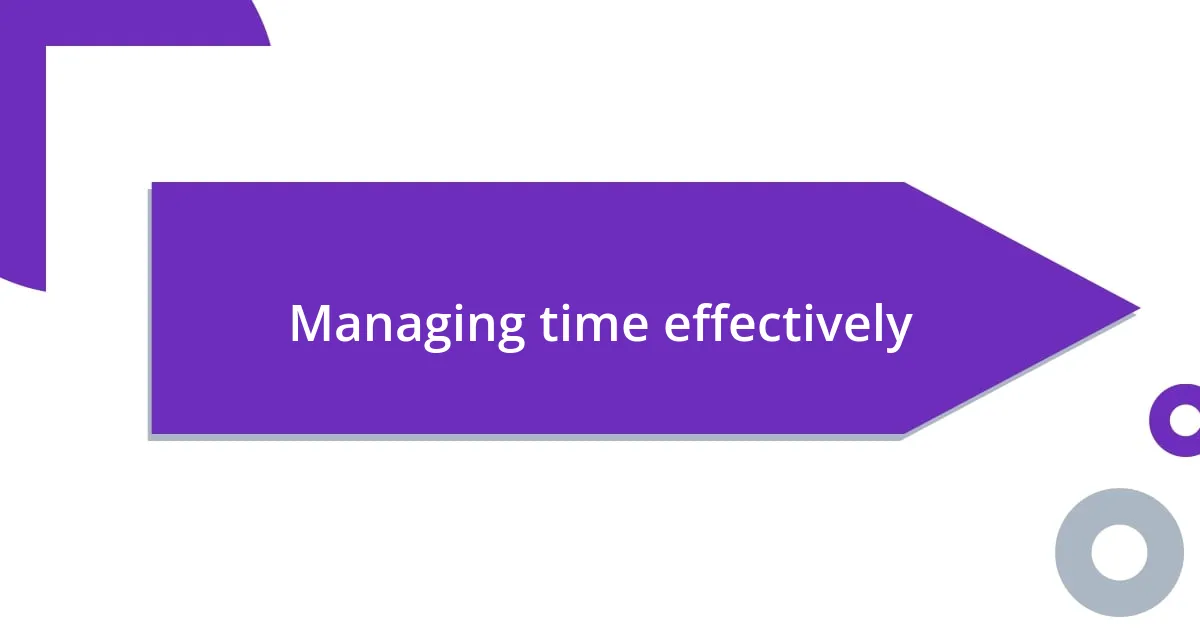
Managing time effectively
Managing time effectively during tech rehearsals is crucial, and I’ve found that creating a strict schedule can work wonders. For instance, I once implemented a detailed timeline that allocated specific time slots for each technical element. It was amazing to see how everyone became more focused and engaged because they knew exactly what to expect. Have you ever noticed how much more efficient things become when there’s a clear plan?
Another strategy that has proved invaluable is setting time limits for troubleshooting. I remember a particularly drawn-out rehearsal where we faced a persistent issue with the sound system. Instead of getting bogged down, I suggested a 15-minute brainstorming session. Surprisingly, we generated more solutions in that short burst of focused energy than we had in an hour of dragging out the conversation. This taught me that sometimes, embracing pressure can ignite creativity.
Lastly, I’ve learned that winding down rehearsal after an intense session is just as important. I like to take the last few minutes to recap what we achieved and where we need to head next. This reflection not only allows the team to feel that sense of accomplishment but also sets the tone for our next rehearsal. Do you ever take time to celebrate small victories? I’ve realized that acknowledging progress, no matter how minor, helps maintain enthusiasm and clarity moving forward. It’s those small moments of reflection that make a big difference in keeping us all energized and focused.
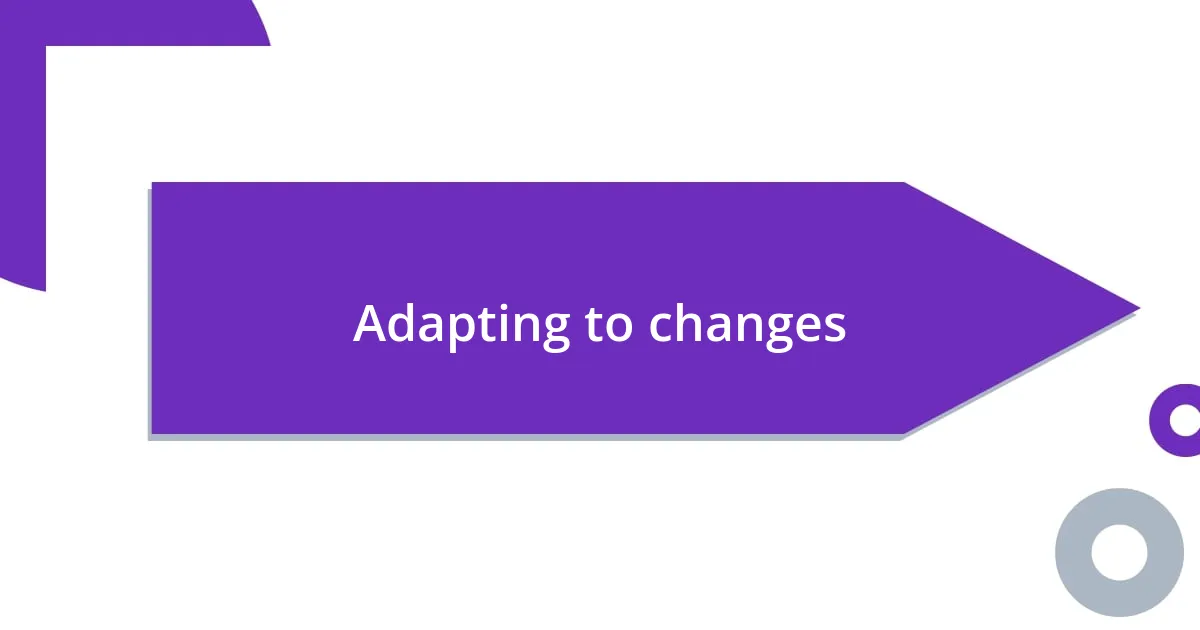
Adapting to changes
Adapting to changes is something I’ve grappled with in tech rehearsals, and I’ve discovered that staying open-minded can turn potential roadblocks into opportunities. I recall a rehearsal where we lost power unexpectedly. Instead of panicking, I suggested we work on our choreography to the rhythms of the music playing on our phones. That moment taught us to embrace the unexpected, and by the end of that session, we had created a unique dance sequence that we otherwise wouldn’t have explored. Have you ever found a hidden gem in a moment of chaos?
Flexibility is key. During one rehearsal, we planned to test a new lighting system, but it didn’t arrive on time. How could we make the best of the situation? I proposed we focus on refining our cues with the existing lights. Surprisingly, that led to a more polished performance and a deeper understanding of our current setup. I learned that sometimes, the best adaptations happen when we’re forced to think outside the box. Have you ever been pleasantly surprised by how a change in plans can enhance a project?
It’s important to foster a culture where adapting is encouraged and celebrated. For example, in another rehearsal, a team member brought up a new software tool that could streamline our workflow. It took courage to voice a change, but I rallied the group to discuss it openly. The enthusiasm was palpable, and we decided to try it on the spot. Watching the team rally behind this fresh idea made me realize that embracing change isn’t just about adapting; it’s about growth and innovation. How often do we allow ourselves to think beyond the obvious? It’s moments like these that can revolutionize how we approach tech rehearsals.
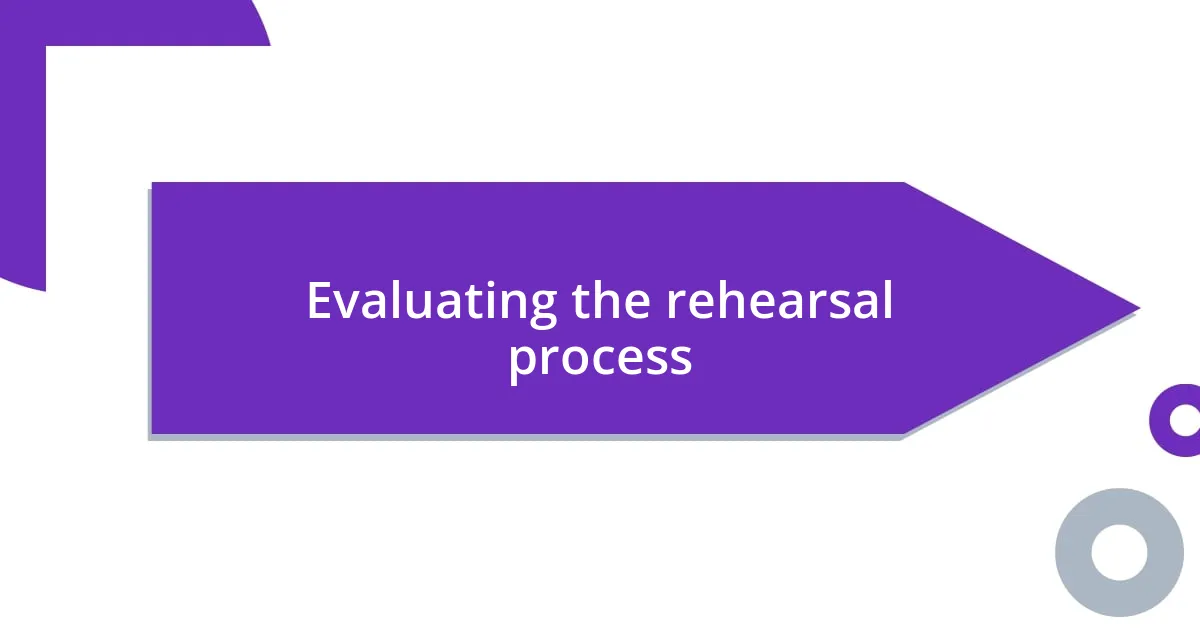
Evaluating the rehearsal process
When I evaluate the rehearsal process, I pay close attention to the dynamics within the team. One time, during a particularly tense rehearsal, I noticed a few team members seemed disconnected. I encouraged an open discussion about our feelings, which turned out to be a game-changer. By hearing each other’s thoughts, we not only strengthened our collaboration but also addressed underlying issues that could have hindered our progress. Have you ever realized how much clearer things can be when everyone shares their perspective?
I’ve also found that reviewing our goals at the end of each rehearsal is crucial. After a long day of practice, I like to gather everyone for a debrief session. In one instance, we accomplished a critical scene that had previously posed challenges, yet nobody took time to appreciate that success. Recognizing our achievements allows us to build confidence and reinforces our commitment to the project. Have you ever noticed how reflecting on moments of triumph can shift the mood of the whole team?
Lastly, I believe in the power of feedback, both given and received. During one rehearsal, I initiated a peer-review process where we could share constructive observations anonymously. This approach not only encouraged honest communication but also highlighted blind spots I hadn’t considered. I felt a sense of relief and excitement as we pieced together different viewpoints, eventually refining our performance. Have you ever experienced that eureka moment when someone else’s insight has illuminated a path you hadn’t seen?












